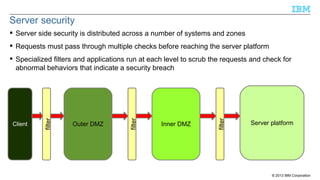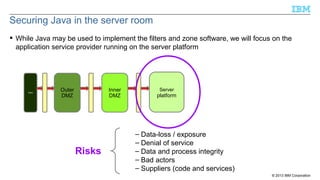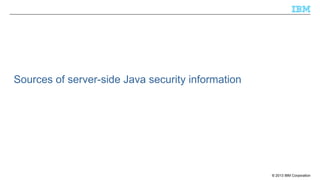JavaOne2013: Securing Java in the Server Room - Tim Ellison
- 1. JavaOne 2013 Securing Java in the Server Room Tim Ellison, IBM United Kingdom Ltd. CON 3636 © 2013 IBM Corporation
- 2. Important Disclaimers THE INFORMATION CONTAINED IN THIS PRESENTATION IS PROVIDED FOR INFORMATIONAL PURPOSES ONLY. WHILST EFFORTS WERE MADE TO VERIFY THE COMPLETENESS AND ACCURACY OF THE INFORMATION CONTAINED IN THIS PRESENTATION, IT IS PROVIDED “AS IS”, WITHOUT WARRANTY OF ANY KIND, EXPRESS OR IMPLIED. ALL PERFORMANCE DATA INCLUDED IN THIS PRESENTATION HAVE BEEN GATHERED IN A CONTROLLED ENVIRONMENT. YOUR OWN TEST RESULTS MAY VARY BASED ON HARDWARE, SOFTWARE OR INFRASTRUCTURE DIFFERENCES. ALL DATA INCLUDED IN THIS PRESENTATION ARE MEANT TO BE USED ONLY AS A GUIDE. IN ADDITION, THE INFORMATION CONTAINED IN THIS PRESENTATION IS BASED ON IBM’S CURRENT PRODUCT PLANS AND STRATEGY, WHICH ARE SUBJECT TO CHANGE BY IBM, WITHOUT NOTICE. IBM AND ITS AFFILIATED COMPANIES SHALL NOT BE RESPONSIBLE FOR ANY DAMAGES ARISING OUT OF THE USE OF, OR OTHERWISE RELATED TO, THIS PRESENTATION OR ANY OTHER DOCUMENTATION. NOTHING CONTAINED IN THIS PRESENTATION IS INTENDED TO, OR SHALL HAVE THE EFFECT OF: - CREATING ANY WARRANT OR REPRESENTATION FROM IBM, ITS AFFILIATED COMPANIES OR ITS OR THEIR SUPPLIERS AND/OR LICENSORS 2 © 2013 IBM Corporation
- 3. About me Based in the Java Technology Centre, Hursley UK Working on various runtime technologies for >20 years Experience of open source communities Currently focused on class library design and delivery Overall technical lead for IBM Java 8 SE [email protected] 3 © 2013 IBM Corporation
- 4. “The only secure computer is one that is unplugged, locked in a safe, and buried 20 feet under ground in a secret location ... and I am not even too sure about that one.” attributed to Dennis Huges, F.B.I. Flickr: buster19761976 © 2013 IBM Corporation
- 5. The nature of server-side security © 2013 IBM Corporation
- 6. Client-side computing Clients perform multiple tasks for a single user Variety of devices, operating systems, and applications Typically connect over untrusted networks Under control of individuals disassociated with the services it uses May be compromised, or deliberately used to challenge the security of the server Flickr: NielsBD © 2013 IBM Corporation
- 7. Server-side computing Servers typically perform a single task for multiple users Usually more powerful computing capacity than clients Running controlled applications Connecting to a wide variety of clients and back end systems Servers are considered a higher value target to attackers because: – more valuable to the owning organization's business – they provide a service to multiple users – have access to data regarding multiple clients / services © 2013 IBM Corporation
- 8. Server security Server side security is distributed across a number of systems and zones Requests must pass through multiple checks before reaching the server platform Inner DMZ filter Outer DMZ filter Client filter Specialized filters and applications run at each level to scrub the requests and check for abnormal behaviors that indicate a security breach Server platform © 2013 IBM Corporation
- 9. Securing the computing platform Host intrusion detection and prevention system – – – – Monitor the system activity to identify and block malicious activities Identify the suspicious activity by comparing to known good signatures of activity Block suspicious activities and raises operator alerts Maintain the integrity of the server Firewall – Interface between trusted and untrusted networks – Ensure server's network connections are within policy – Limited level of application knowledge security Antivirus software – Identify and prevent spread of malware in the trusted network – Often black-list or heuristics based – Servers can have more restrictive white-list detection © 2013 IBM Corporation
- 10. Securing the cloud computing platform Cloud service platforms – Service provider must be trusted – Outsourcing some security considerations (can be a good thing!) – Ability to control details of server infrastructure is limited – Sensitive data must leave the organization Virtualized servers – Resources are shared, potentially with untrusted tenants – Applications may be migrated dynamically between hosts – Protection appliances and software should be virtualization-aware © 2013 IBM Corporation
- 11. Securing Java in the server room While Java may be used to implement the filters and zone software, we will focus on the application service provider running on the server platform Client Outer DMZ Inner DMZ Risks Server platform – Data-loss / exposure – Denial of service – Data and process integrity – Bad actors – Suppliers (code and services) © 2013 IBM Corporation
- 12. Writing secure applications in Java Secure applications require a whole life-cycle approach – Secure requirements, threat modelling, risk analysis, secure coding, security testing, security documentation, incident response policy – Management of third-party dependencies – Source code management – Coding guidelines – Compiler settings and analysis tools – Explicit security testing Use Java's strengths appropriately – – – – – Java has strong typing, array bounds checking, bytecode verification, JAR signing, ... Java also has a number of legacy/unsafe APIs and defaults that are inappropriate for secure coding No strong model for data security May have to call out to other languages ...this is where there are lessons to be learnt © 2013 IBM Corporation
- 13. Sources of server-side Java security information © 2013 IBM Corporation
- 14. Common Vulnerabilities and Exposures Standardized naming authority for known vulnerabilities and exposures A common name helps identify the same issue across multiple vendors, tools, releases, etc Contains brief information, such as status indicator, short description, and related issues No description of impact, fix information, or detailed technical information Contains approx. 57,000 CVEs National Vulnerability Database US Government repository for vulnerability management data Indexed by CVE, gives assessment of impact, complexity of exploit, technical details, and links to vendor information, etc Utilizes the “Common Vulnerability Scoring System (CVSS)” to assess vulnerabilities © 2013 IBM Corporation
- 15. Common Weakness Enumeration List of software weaknesses across various languages – – – – Sponsored by Office of Cybersecurity and Communications, U.S. Department of Homeland Security Contributions by a broad community including a wide variety of organizations Shared resource for software developers, tools vendors, security researchers, educators, etc. CWE Compatibility and Effectiveness Program for certifying products and services CWE version 2.5 – 940 vulnerabilities described, categorized into 187 different categories – Complete with taxonomy, examples, consequences, relationships, etc. – 73 are classified as weaknesses specific to software written in Java The “Top 25 CWEs” represent the most significant exploitable software constructs Utilizes the Common Weakness Scoring System, and Common Weakness Risk Analysis Framework – Gives a quantitative measurement of the unfixed weaknessis in an application – Rates weaknesses in terms of impact to business © 2013 IBM Corporation
- 16. Open Web Application Security Project Community driven open source materials related to software security – Raising awareness about risks and specific coding vulnerabilitites – Advocate risk management approach rather than find and patch Publish a Top 10 list of most critical web app security risks Vulnerabilities are classified to enable the likely impact to the business © 2013 IBM Corporation
- 17. Vendor Security Bulletins Specific information about security vulnerabilities that may affect vendor products are published on-line Java Specific Notices e.g. IBM Product Security Incident Response – https://www.ibm.com/blogs/PSIRT e.g. Oracle Critical Patch Updates, Security Alerts and Third Party Bulletin – http://www.oracle.com/technetwork/topics/security/alerts086861.html © 2013 IBM Corporation
- 18. A closer look at server-side security © 2013 IBM Corporation
- 19. Simplified Server Application Architecture Useful to consider the various weaknesses in the context of a simplified server architecture User Sessions & Data Application Middleware Java filter OS Platform Client Interface Database data data © 2013 IBM Corporation
- 20. Computing Platform User Sessions Application Potential issues attributed to the application's computing platform Risks from mis-configuration or manipulation of the computer system hosting the application. Middleware Java OS Platform Client Interface Database Vulnerabilities affecting the safe and secure operation of the application and its data by deliberate or inadvertent unauthorized manipulation of the system. Examples CWE-842: Placement of User into Incorrect Group The software or the administrator places a user into an incorrect group. CWE-605: Multiple Binds to the Same Port When multiple sockets are allowed to bind to the same port, other services on that port may be stolen or spoofed. CWE-405: Asymmetric Resource Consumption (Amplification) Software that does not appropriately monitor or control resource consumption can lead to adverse system performance. Sometimes this is a factor in "flood" attacks, but other types of amplification exist.
- 21. Java Platform User Sessions Application Potential issues attributed to Java-specific weaknesses Using APIs as they are intended to be used, and adopting mitigating actions for those with known high risk. Middleware Java OS Platform Client Interface Database Designing the application and using coding patterns that promote secure practices, while avoiding those shown to be at risk of introducing vulnerabilities. Examples CWE-227: Improper Fulfillment of API Contract ('API Abuse') The software uses an API in a manner contrary to its intended use, or makes assumptions that are not assured by the API documentation. CWE-487: Reliance on Package Level Scope Java packages are not inherently closed; therefore, relying on them for code security is not a good practice. CWE-470: Use of Externally-Controlled Input to Select Classes or Code ('Unsafe Reflection') The application uses external input with reflection to select which classes or code to use, but it does not sufficiently prevent the input from selecting improper classes or code.
- 22. Application and Middleware User Sessions Application Potential issues attributed to concepts in the application middleware stack Ensuring correct usage of high-level concepts and their semantics by developers. Middleware Java OS Platform Client Interface Database Potential risks by defining behavior and manipulating data at Examples different levels of application-defined authority. CWE-95: Improper Neutralization of Directives in Dynamically Evaluated Code ('Eval Injection') The software receives input from an upstream component, but it does not neutralize or incorrectly neutralizes code syntax before using the input in a dynamic evaluation call (e.g. "eval"). CWE-579: J2EE Bad Practices: Non-serializable Object Stored in Session The application stores a non-serializable object as an HttpSession attribute, which means the session cannot be replicated across JVMs. CWE-613: Insufficient Session Expiration Insufficient Session Expiration is when a web site permits an attacker to reuse old session credentials or session IDs for authorization.
- 23. User Sessions User Sessions Potential issues attributed to concepts in management of user level controls Java Ensuring that the logical unit of work encapsulated as application sessions are secure, robust, and do not lead to data exposure. Application Middleware OS Platform Client Interface Database Protecting the integrity of shared secrets and methods for establishing identity of users, systems, applications, etc Examples CWE-268: Privilege Chaining Privileges, roles, capabilities, or rights can be combined in a way that allows an entity to perform unsafe actions that would not be allowed without that combination. CWE-272: Least Privilege Violation Elevated privilege levels required to perform operations should be dropped immediately after the operation is performed. CWE-784: Reliance on Cookies without Validation and Integrity Checking in a Security Decision Attackers can easily modify cookies and can bypass protection mechanisms such as authorization and authentication by modifying the cookie to contain an expected value. CWE-732: Incorrect Permission Assignment for Critical Resource Giving permissions to a wider range of actors than required, could lead to the exposure of sensitive information, or the modification of that resource by unintended parties.
- 24. Client Interface User Sessions Risks for systems that depend upon secure communications Application Middleware Avoiding numerous risks that may diminish the assurances of secrecy through the use of cryptographic techniques. Java OS Platform Client Interface Database Protecting the integrity of secure data exchange and methods for establishing identity of the participants. Examples CWE-327: Use of a Broken or Risky Cryptographic Algorithm The use of a broken or risky cryptographic algorithm is an unnecessary risk that may result in the exposure of sensitive information. CWE-337: Predictable Seed in PRNG A PRNG is initialized from a predictable seed, e.g. using process ID or system time. CWE-299: Improper Check for Certificate Revocation The software does not check or incorrectly checks the revocation status of a certificate, which may cause it to use a certificate that has been compromised. CWE-297: Improper Validation of Certificate with Host Mismatch The software communicates with a host that provides a certificate, but the software does not properly ensure that the certificate is actually associated with that host.
- 25. Database User Sessions Risks in managing the data you use to achieve a business objective Application Middleware Risks associated with application data being modified by, or exposed to, those with no business need for such access. Java OS Platform Client Interface Database Increasing the security assurances around application data that is exposed to external storage, either temporarily or permanently. Examples CWE-313: Cleartext Storage in a File or on Disk The application stores sensitive information in cleartext in a file, or on disk that could be read by attackers with access to the file, or with physical or administrator access to the raw disk. CWE-499: Serializable Class Containing Sensitive Data The code contains a class with sensitive data, but the class does not explicitly deny serialization. The data can be accessed by serializing the class through another class. CWE-359: Privacy Violation Mishandling private information, such as customer passwords or social security numbers, can compromise user privacy and is often illegal..
- 26. System Data User Sessions Consideration of risks handling data associated with the computing platform itself Risks associated with storing descriptive system history in shared log locations. Application Middleware Java OS Platform Client Interface Database Risks of inadvertently disclosing through system tools and behavior information that is protected by the application. Examples CWE-532: Information Exposure Through Log Files While logging all information may be helpful during development stages, it is important that logging levels be set appropriately before a product ships so that sensitive user data and system information are not accidentally exposed to potential attackers. CWE-208: Information Exposure Through Timing Discrepancy Two separate operations in a product require different amounts of time to complete, in a way that is observable to an actor and reveals security-relevant information about the state of the product, such as whether a particular operation was successful or not. CWE-530: Exposure of Backup File to an Unauthorized Control Sphere A backup file is stored in a directory that is accessible to actors outside of the intended control sphere.
- 27. Summary – securing Java in the server room Planning risk assessment for type of application define integrity and confidentiality goals identify applicable policies assurances about the computing platform Development secure engineering practices mitigation and avoidance of known risks security testing and review user and administrator guidance Operations configuration management control and auditing intrusion detection and monitoring action plan for dealing with security incidents contingency planning




























